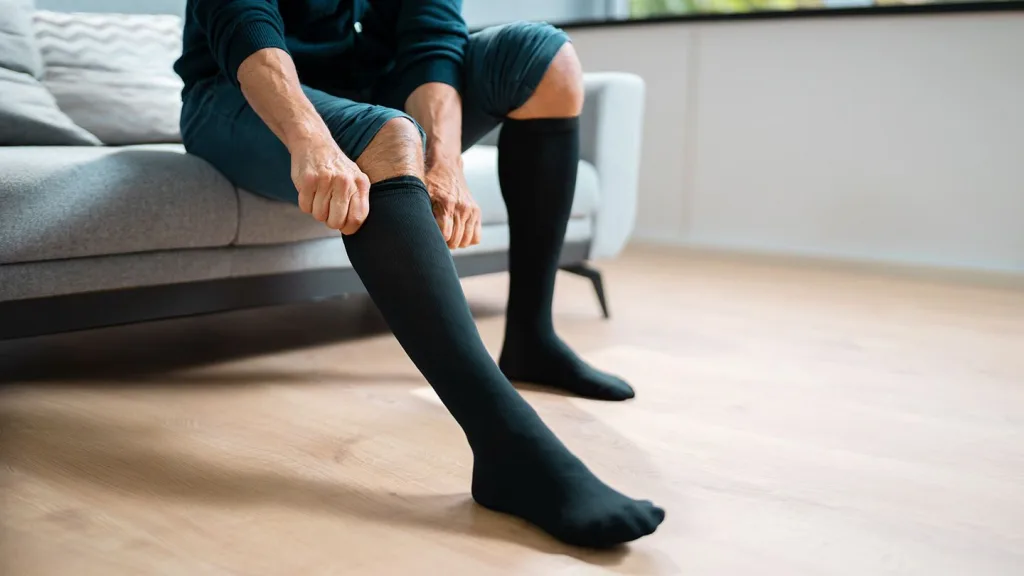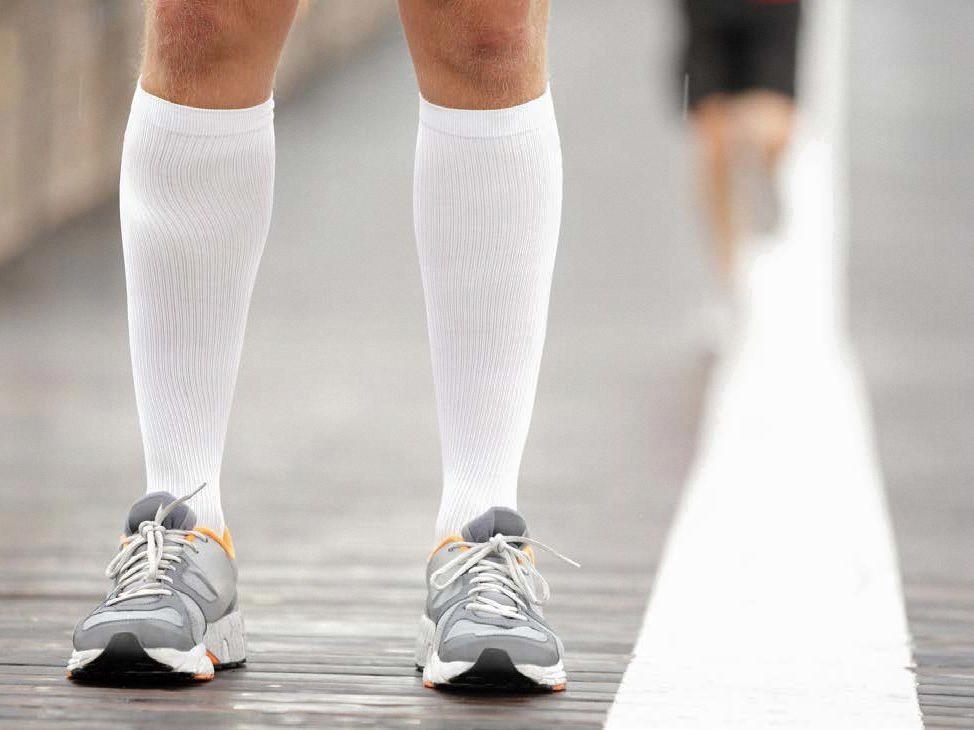Clot is a medical term used to describe a localised thickening of the blood that forms into a solid mass. A clot can be caused by a number of factors, including dehydration, injury, surgery, or medications. If left untreated, a clot can cause serious health issues such as deep vein thrombosis (DVT) and pulmonary embolism (PE).
Compression stockings are commonly used to help reduce swelling and improve circulation in the legs. These special socks are designed to fit snugly around your legs and use graduated compression to improve blood flow throughout the leg. Many people find that wearing compression stockings helps relieve leg pain and prevents DVT.
The main question related to clot and compression stockings is wheher or not they can help remove or dislodge an existing clot. The answer is no; compression stockings cannot be used to dislodge an existing clot. Compression stockings may help reduce the risk of DVT by improving circulation in the legs and reducing swelling, but they cannot actually “remove” an existing clot from the body.
If you think you may have a clot in your leg, it is important to seek medical attention right away. It is possible that your doctor may recommend wearing compression stockings while you are being treated for the clot; however, they should not be used as a substitute for proper medical care. Your doctor may also suggest taking blood thinners such as aspirin or heparin to treat your condition.
Compression stockings can be an effective tool for improving circulation in the legs and reducing swelling; however, they should not be used as a substitute for proper medical care when dealing with clots. If you suspect that you may have a clot in your leg, it is important to seek medical attention right away so that it can be properly treated before any further damage occurs.
The Effect of Compression Socks on Blood Clot Mobility
Compression socks cannot cause blood clots to move. While wearing compression socks can increase circulation, it does not create enough pressure to move existing blood clots. In fact, wearing compression socks is recommended for people who have already formed a clot to help prevent further clotting and reduce symptoms. It is important to remember that compression socks should only be worn under the direction of a medical professional and should be removed immediately if any signs of blood clots are present.

The Potential Risk of Worsening Deep Vein Thrombosis with Compression Socks
No, compression socks should not make DVT worse. Compression socks can help to reduce the risk of developing DVT by helping to increase blood flow and reduce swelling in the legs. When worn correctly, they can also help to reduce pain and discomfort associated with existing DVT. If you are at risk for developing DVT or are experiencing any symptoms, it is best to speak with your doctor about the best treatment for you.
When Not to Wear Compression Stockings
Compression stockings should not be worn if you have any kind of peripheral vascular disease in your lower extremities. Peripheral vascular disease is a condition in which there is an obstruction or narrowing of the blood vessels in the legs, leading to poor circulation and pain. Wearing compression stockings can increase pressure on these affected areas, worsening symptoms and potentially causing further damage. If you are diagnosed with peripheral vascular disease, talk to your doctor about what types of treatments may be best for you.
Treating a Deep Vein Thrombosis (DVT) Blood Clot
In order to dislodge a blood clot caused by Deep Vein Thrombosis (DVT), treatment typically requires the use of anticoagulants or blood thinners. These medications help reduce the clot’s size and stop it from growing larger. In some cases, a doctor may also recommend oter treatments such as the use of compression stockings or thrombolytics, which are medications that break down clots. Additionally, doctors may suggest physical therapy or surgery to remove the clot. It is important to follow your doctor’s instructions and take all prescribed medications as directed in order to properly treat DVT and reduce the risk of complications.
The Benefits of Compression for Blood Clot Treatment
Yes, compression is beneficial for blood clots. Intermittent pneumatic compression (IPC) devices are used to help prevent deep vein thrombosis (DVT), a dangerous condition that is caused by blood clots in the deep veins of the legs. IPC works by using cuffs filled with air that are wrapped around your legs and then inflated and deflated periodically, which helps increase blood flow through your veins and reduces the risk of clot formation. Properly applied compression therapy has been proven to reduce the risk of DVT in clinical studies.

Source: healthline.com
The Benefits of Compression for DVT Treatment
Yes, you can put compression on a DVT. Compression stockings are often recommended for people who have had a deep vein thrombosis (DVT). The stockings work by squeezing the legs in order to increase blood flow and reduce swelling. Compression stockings can also help to prevent the formation of new clots. However, the updated CHEST guidelines do not recommend the routine use of compression stockings after DVT to prevent post-thrombotic syndrome. It is important to speak with your doctor before using compression stockings as they may be contraindicated in certain cases.
What Not to Do If You Have a DVT
If you have been diagnosed with a Deep Vein Thrombosis (DVT), there are certain activities and behaviors that shold be avoided. It is important to take measures to prevent further complications, such as a pulmonary embolism. To do this, do not stand or sit in one spot for extended periods of time. Make sure your clothing does not restrict blood flow in your legs, as this can exacerbate the condition. Additionally, it is important to avoid smoking, as this increases your risk of developing DVT. Lastly, if you are taking blood thinners, it is best to avoid contact sports due to the potential risk of bleeding from trauma.
Consequences of an Undissolved DVT
DVT stands for deep vein thrombosis, a type of blood clot that forms deep within the veins. If a DVT does not dissolve on its own, it can cause long-term health problems. The clot can become larger, break off and travel through the bloodstream to oher areas of the body. This can lead to a pulmonary embolism—a blockage in an artery in your lung that can be fatal if not treated right away. It’s also possible for pieces of the clot to break off and travel through the bloodstream, causing blockages in other parts of your body such as your heart or brain. To prevent this, doctors may recommend anticoagulant medications or surgery to remove the clot and reduce your risk of complications.
Wearing Compression Socks After a Blood Clot: How Long Should You Wear Them?
Compression socks are an important part of recovery after a blood clot, as they help to reduce swelling and prevent further clots from forming. According to a study by researchers at Leiden University Medical Center in the Netherlands, most patients can safely wear compression socks for up to two years after a blood clot without increasing their risk of complications. The best course of action is to discuss with your doctor what the optimal length of time is for you specifically.

Source: thrombosis.org
Recommended Usage of Compression Stockings
Compression stockings should be worn for at least 8 hours a day, although some people may need to wear them for longer. It is important to follow the advice of your healthcare professional in determining how long you should wear compression stockings. Generally speaking, if you are using them to reduce swelling or prevent blood clots, they should be worn all day and taken off before going to bed. If you are using them for other reasons, such as reducing pain or improving circulation, then it is best to wear them for as long as possible during the day.
The Risks of Wearing Compression Socks for Too Long
If you leave compression socks on too long, it can cause a lot of problems. The skin beneath the socks can become irritated and the constant pressure can restrict blood flow, leading to decreased oxygen levels in the tissue. This decreased oxygen can lead to the breakdown of skin tissue, which increases the risk of infection. Additionally, if you are wearing them for a medical reason, leaving them on too long can mean that your condition is not being treated properly. It’s important to follow your doctor’s instructions and wear them as prescribed.
The Benefits and Risks of Sleeping with Compression Stockings On
No, it is not recommended that you sleep with compression stockings on. Compression stockings are designed to help improve blood flow in your legs by applying pressure to the lower extremities. When you are lying down in bed, the effects of gravity on your blood flow are minimized, meaning that wearing compression stockings while sleeping will not provide any additional benefit. Additionally, some people find that they are uncomfortable to sleep in and can case skin irritation or chafing. Therefore, it is best to remove them before going to bed and put them back on in the morning when you wake up.
Signs of a Moving Blood Clot
If a blood clot is moving, you may experience symptoms such as swelling and pain in the affected area, warmth or redness of the skin around the clot, shortness of breath, chest pain, lightheadedness, palpitations (feeling your heart racing or skipping beats), coughing up blood, and/or a fever. Depending on the size and location of the clot, it could cause more serious problems such as a stroke or heart attack. It is important to seek medical attention immediately if you believe you have a blood clot that is moving.
Forcing a Blood Clot Out
In order to force a blood clot out, the doctor will perform a procedure called thrombectomy. During this procedure, the doctor makes a small incision in the skin above the clot. Then they use a thin tube (catheter) with a balloon attached to it to break up and extract the clot from the blood vessel. A stent may be installed in the vessel afterwards to help keep it open. The whole procedure is minimally invasive and typically done using local anesthesia or conscious sedation.
Dissolving Blood Clots Faster
The most effective way to dissolve a blood clot is to use thrombolytic drugs, which work by activating plasmin, an enzyme that helps break down the clot. These drugs work quickly to help break down the clot and prevent it from blocking blood flow. They are commonly used for serious conditions such as pulmonary embolisms. Other treatments for blood clots include anticoagulants, which help thin the blood and reduce the risk of further clots forming; and catheter-directed thrombolysis, which uses a catheter to deliver medication directly into the clot. However, thee treatments are more invasive and less efficient than thrombolytics. It’s important to speak with a doctor before beginning any treatment for a blood clot in order to determine the best method for you.
Conclusion
In conclusion, deep vein thrombosis is a serios health issue that can be prevented and managed with proper care. Compression socks are a safe and effective way to reduce swelling, prevent DVT, and improve circulation. However, people with peripheral vascular disease should not wear compression socks as the pressure may make ischemic disease worse. Blood thinners are the most common medication used to treat DVT and must be taken for 6 months in some cases. If symptoms are severe or the clot is very large, a strong medicine may be prescribed to dissolve it. It is important to consult a doctor if you experience any signs or symptoms of DVT so they can properly diagnose and treat your condition.
